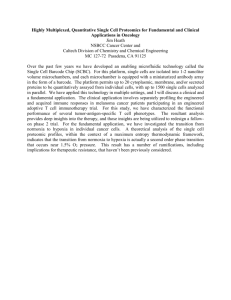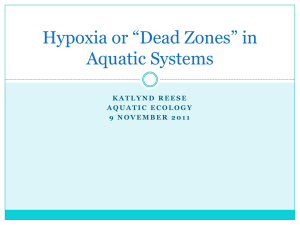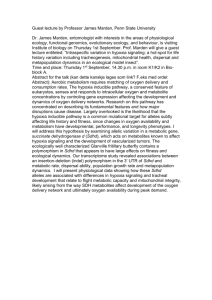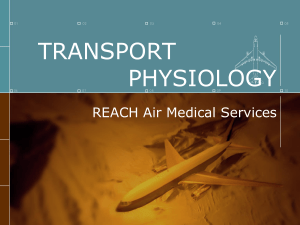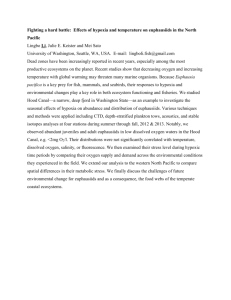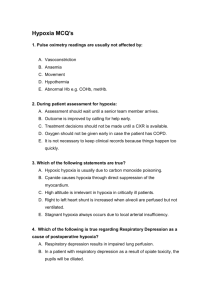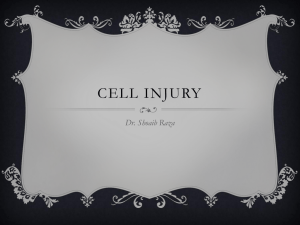Assignment 9
advertisement
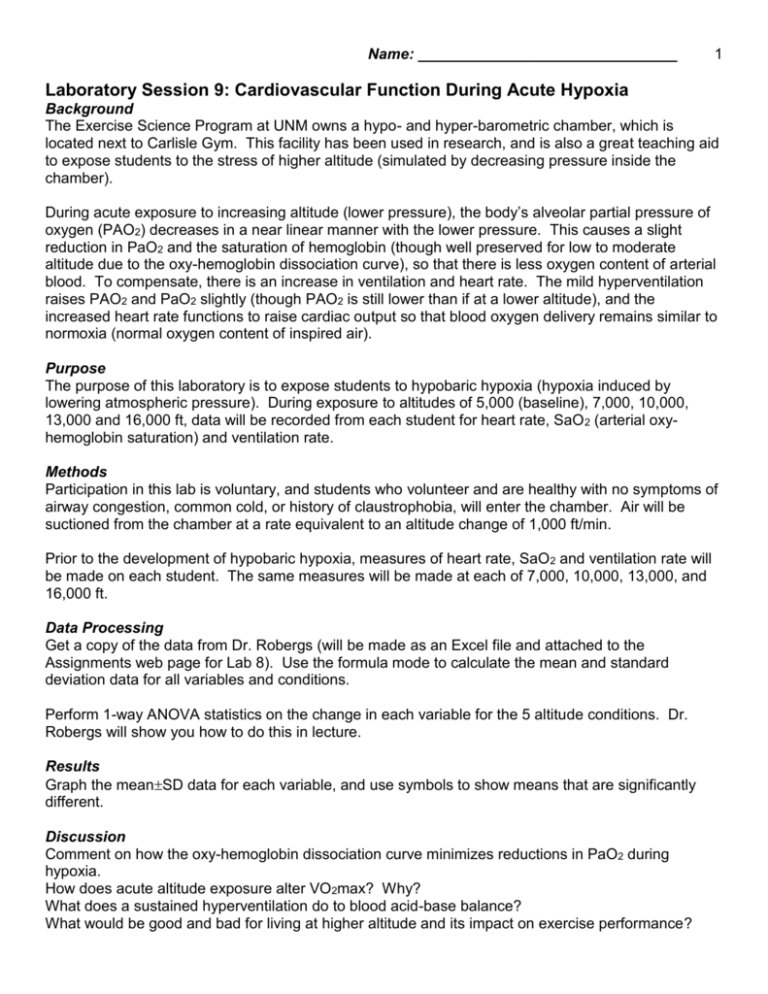
Name: _______________________________ 1 Laboratory Session 9: Cardiovascular Function During Acute Hypoxia Background The Exercise Science Program at UNM owns a hypo- and hyper-barometric chamber, which is located next to Carlisle Gym. This facility has been used in research, and is also a great teaching aid to expose students to the stress of higher altitude (simulated by decreasing pressure inside the chamber). During acute exposure to increasing altitude (lower pressure), the body’s alveolar partial pressure of oxygen (PAO2) decreases in a near linear manner with the lower pressure. This causes a slight reduction in PaO2 and the saturation of hemoglobin (though well preserved for low to moderate altitude due to the oxy-hemoglobin dissociation curve), so that there is less oxygen content of arterial blood. To compensate, there is an increase in ventilation and heart rate. The mild hyperventilation raises PAO2 and PaO2 slightly (though PAO2 is still lower than if at a lower altitude), and the increased heart rate functions to raise cardiac output so that blood oxygen delivery remains similar to normoxia (normal oxygen content of inspired air). Purpose The purpose of this laboratory is to expose students to hypobaric hypoxia (hypoxia induced by lowering atmospheric pressure). During exposure to altitudes of 5,000 (baseline), 7,000, 10,000, 13,000 and 16,000 ft, data will be recorded from each student for heart rate, SaO 2 (arterial oxyhemoglobin saturation) and ventilation rate. Methods Participation in this lab is voluntary, and students who volunteer and are healthy with no symptoms of airway congestion, common cold, or history of claustrophobia, will enter the chamber. Air will be suctioned from the chamber at a rate equivalent to an altitude change of 1,000 ft/min. Prior to the development of hypobaric hypoxia, measures of heart rate, SaO 2 and ventilation rate will be made on each student. The same measures will be made at each of 7,000, 10,000, 13,000, and 16,000 ft. Data Processing Get a copy of the data from Dr. Robergs (will be made as an Excel file and attached to the Assignments web page for Lab 8). Use the formula mode to calculate the mean and standard deviation data for all variables and conditions. Perform 1-way ANOVA statistics on the change in each variable for the 5 altitude conditions. Dr. Robergs will show you how to do this in lecture. Results Graph the meanSD data for each variable, and use symbols to show means that are significantly different. Discussion Comment on how the oxy-hemoglobin dissociation curve minimizes reductions in PaO2 during hypoxia. How does acute altitude exposure alter VO2max? Why? What does a sustained hyperventilation do to blood acid-base balance? What would be good and bad for living at higher altitude and its impact on exercise performance? Name: _______________________________ 2 References 1: Fukuda T, Maegawa T, Matsumoto A, Komatsu Y, Nakajima T, Nagai R, Kawahara T. Effects of acute hypoxia at moderate altitude on stroke volume and cardiac output during exercise. Int Heart J. 2010 May;51(3):170-5. 2: Mollard P, Bourdillon N, Letournel M, Herman H, Gibert S, Pichon A, Woorons X, Richalet JP. Validity of arterialized earlobe blood gases at rest and exercise in normoxia and hypoxia. Respir Physiol Neurobiol. 2010 Jul 31;172(3):179-83. 3: Vogt M, Hoppeler H. Is hypoxia training good for muscles and exercise performance? Prog Cardiovasc Dis. 2010 May-Jun;52(6):525-33. 4: Kon M, Ikeda T, Homma T, Akimoto T, Suzuki Y, Kawahara T. Effects of acute hypoxia on metabolic and hormonal responses to resistance exercise. Med Sci Sports Exerc. 2010 Jul;42(7):1279-85. 5: Lecoultre V, Boss A, Tappy L, Borrani F, Tran C, Schneiter P, Schutz Y. Training in hypoxia fails to further enhance endurance performance and lactate clearance in well-trained men and impairs glucose metabolism during prolonged exercise. Exp Physiol. 2010 Feb;95(2):315-30. 6: Sheel AW, MacNutt MJ, Querido JS. The pulmonary system during exercise in hypoxia and the cold. Exp Physiol. 2010 Mar;95(3):422-30. Epub 2009 Oct 23. 7: Zupet P, Princi T, Finderle Z. Effect of hypobaric hypoxia on heart rate variability during exercise: a pilot field study. Eur J Appl Physiol. 2009 Oct;107(3):345-50. 8: Bonetti DL, Hopkins WG. Sea-level exercise performance following adaptation to hypoxia: a metaanalysis. Sports Med. 2009;39(2):107-27. 9: Calbet JA, Robach P, Lundby C, Boushel R. Is pulmonary gas exchange during exercise in hypoxia impaired with the increase of cardiac output? Appl Physiol Nutr Metab. 2008 Jun;33(3):593600. 10: Subudhi AW, Lorenz MC, Fulco CS, Roach RC. Cerebrovascular responses to incremental exercise during hypobaric hypoxia: effect of oxygenation on maximal performance. Am J Physiol Heart Circ Physiol. 2008 Jan;294(1):H164-71. 11: Amann M, Pegelow DF, Jacques AJ, Dempsey JA. Inspiratory muscle work in acute hypoxia influences locomotor muscle fatigue and exercise performance of healthy humans. Am J Physiol Regul Integr Comp Physiol. 2007 Nov;293(5):R2036-45. 12: Woorons X, Mollard P, Pichon A, Lamberto C, Duvallet A, Richalet JP. Moderate exercise in hypoxia induces a greater arterial desaturation in trained than untrained men. Scand J Med Sci Sports. 2007 Aug;17(4):431-6. 13: Péronnet F, Massicotte D, Folch N, Melin B, Koulmann N, Jimenez C, Bourdon L, Launay JC, Savourey G. Substrate utilization during prolonged exercise with ingestion of (13)C-glucose in acute hypobaric hypoxia (4,300 m). Eur J Appl Physiol. 2006 Jul;97(5):527-34. Name: _______________________________ 14: Dufour SP, Ponsot E, Zoll J, Doutreleau S, Lonsdorfer-Wolf E, Geny B, Lampert E, Flück M, Hoppeler H, Billat V, Mettauer B, Richard R, Lonsdorfer J. Exercise training in normobaric hypoxia in endurance runners. I. Improvement in aerobic performance capacity. J Appl Physiol. 2006 Apr;100(4):1238-48. 15: Zoll J, Ponsot E, Dufour S, Doutreleau S, Ventura-Clapier R, Vogt M, Hoppeler H, Richard R, Flück M. Exercise training in normobaric hypoxia in endurance runners. III. Muscular adjustments of selected gene transcripts. J Appl Physiol. 2006 Apr;100(4):1258-66. 16: Robergs RA, Quintana R, Parker DL, Frankel CC. Multiple variables explain the variability in the decrement in VO2max during acute hypobaric hypoxia. Med Sci Sports Exerc. 1998 Jun;30(6):86979. 3

